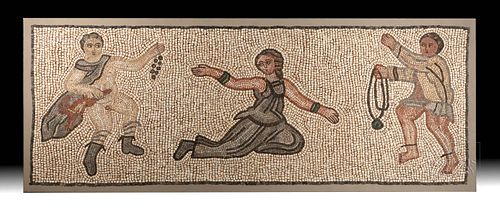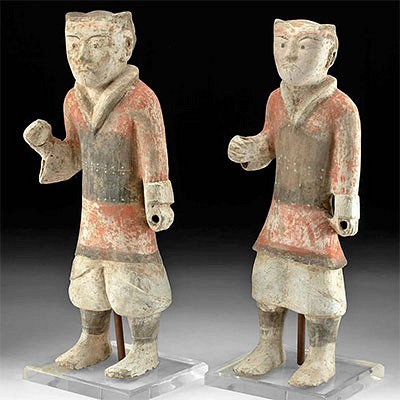Late Roman Mosaic - Bacchic Ceremonial Dancers
Lot 10a
About Seller
Artemis Fine Arts
686 S Taylor Ave, Ste 106
Louisville, CO 80027
United States
Selling antiquities, ancient and ethnographic art online since 1993, Artemis Gallery specializes in Classical Antiquities (Egyptian, Greek, Roman, Near Eastern), Asian, Pre-Columbian, African / Tribal / Oceanographic art. Our extensive inventory includes pottery, stone, metal, wood, glass and textil...Read more
Categories
Estimate:
$24,000 - $36,000
Absentee vs Live bid
Two ways to bid:
- Leave a max absentee bid and the platform will bid on your behalf up to your maximum bid during the live auction.
- Bid live during the auction and your bids will be submitted real-time to the auctioneer.
Bid Increments
| Price | Bid Increment |
|---|---|
| $0 | $25 |
| $300 | $50 |
| $1,000 | $100 |
| $2,000 | $250 |
| $5,000 | $500 |
| $10,000 | $1,000 |
| $20,000 | $2,500 |
| $50,000 | $5,000 |
| $100,000 | $10,000 |
| $200,000 | $20,000 |
About Auction
By Artemis Fine Arts
May 25, 2023
Set Reminder
2023-05-25 10:00:00
2023-05-25 10:00:00
America/New_York
Bidsquare
Bidsquare : ON-SALE! Antiquities, Pre-Columbian, Ethno, Fine Art
https://www.bidsquare.com/auctions/artemis-gallery/on-sale-antiquities-pre-columbian-ethno-fine-art-12860
ON-SALE Antiquities, Pre-Columbian, Ethno, More! Artemis Fine Arts info@artemisgallery.com
ON-SALE Antiquities, Pre-Columbian, Ethno, More! Artemis Fine Arts info@artemisgallery.com
- Lot Description
Late Roman or Early Byzantine, the Levant, late Imperial Period, ca. 4th to 6th century CE. A very fine Roman mosaic comprised of thousands of stone tesserae, the rectangular composition depicting three dancers - two male figures flanking a central female. The males are both presented in composite profile, their bodies oriented toward the female, and each holds a lovely strand of green beads - the man on the left also holds a deer. The female assumes a dramatic pose with her arms extended out toward the beaded strands held by her male partners, her torso turned in 3/4 view, her left leg bent at the knee, and her right leg extended out. The figures are meticulously modeled with tiny colorful tesserae of gradated beige, salmon, grey, black, and white hues. The man on the left is nude save a grey cape over his shoulder and grey foot coverings with ties around the legs. The man on the right wears a blousy shirt and anklets on otherwise nude legs. The female wears voluminous garments, green double bracelets, and a twisted coiffure. Size: 68" W x 24.75" H (172.7 cm x 62.9 cm); 70.75" W x 27.25" H (179.7 cm x 69.2 cm) w/ matrix
Perhaps these are Bacchic ceremonial dancers. Perhaps they are theatrical performers. The Romans are known for developing entertainment ampitheatres built of stone and establishing a vibrant theatre tradition - the most famous ampitheatre of them all being the Colosseum. On the Colosseum's upper galleries are mosaics of dancers and actors. Music and dance were beloved forms of entertainment in Roman theatre. Although no written ancient music has survived in legible form, we can still use our imaginations to hear the sounds created by harpists, flautists, and tambourine players.
Mosaics (opus tesellatum) are some of our enduring images from the Roman world, appreciated not only for their aesthetic beauty, but also because they reveal what Romans chose to depict and see every day decorating their private and public spaces. In the Roman province of Syria, which encompassed most of the ancient Near East/Levant, mosaics seem to have developed as a common art form relatively late, with most finds coming from the 3rd century CE or later. Syria was one of Rome's wealthiest provinces, but it was also far removed from Rome itself and Roman culture was overlaid on enduring cultural traditions from Hellenistic Greece and the great civilizations that came before it. Antioch-on-the-Orontes (modern day Antakya, Turkey), was the capital of northern Roman Syria, and its excavations in the 1930s revealed more than three hundred mosaic pavements.
Provenance: East Coast collection, New York Gallery, New York City, New York, USA, acquired before 2010
All items legal to buy/sell under U.S. Statute covering cultural patrimony Code 2600, CHAPTER 14, and are guaranteed to be as described or your money back.
A Certificate of Authenticity will accompany all winning bids.
We ship worldwide and handle all shipping in-house for your convenience.
#146421Old chips and fissures to some tesserae with some losses as shown, but the imagery is still quite vivid. Tesserae are ancient. Set in a modern matrix with metal framing. Suspension holes on the verso.Condition
- Shipping Info
-
All shipping is handled in-house for your convenience. Your invoice from Artemis Gallery will include shipping calculation instructions. If in doubt, please inquire BEFORE bidding for estimated shipping costs for individual items.
-
- Buyer's Premium



 EUR
EUR CAD
CAD AUD
AUD GBP
GBP MXN
MXN HKD
HKD CNY
CNY MYR
MYR SEK
SEK SGD
SGD CHF
CHF THB
THB
















